A very interesting sourdough starter made from fermented raisins and a delicious whole wheat bread with olive oil and oregano.

This post is about a delicious whole wheat bread with oregano and olive oil, and a simple method on how to make your own sourdough starter from raisin water. The bread recipe is very flavorful and can also be made with dry yeast instead of a sourdough starter. Olive oil and oregano flavor the bread beautifully, giving it a Mediterranean flair, while at the same time the oil tenderizes the crumb making it softer. The raisin water starter took 8 whole days to be ready, with the temperature inside my house being about 73 °F (23 °C). I believe that if you keep it in a warmer place or if you make it during a hot week, it will need fewer days to be ready.

How the story began…
Some while ago, I saw a post from Natasha (My Daily Sourdough Bread) that caught my eye. Actually, everything Natasha post's catches my eye, because she makes some of the most beautiful bread in the world! Not to mention that she is the Queen of sourdough – I mean, she has even made sourdough croissants, how cool is that? Anyway, Natasha posted a raisin water starter sourdough bread, and I was immediately intrigued. I already knew what sourdough bread was since an aunt of mine keeps a live sourdough for years now and regularly makes bread with it, but I had never before heard about this raisin water starter. Some years ago I had even made my own sourdough from scratch, but since I don’t bake bread too often, it ultimately died 🙁

I knew I had to try this new kind of sourdough since it used fermented raisins and it reminded me a lot of the procedure we follow in Crete to make raki. Raki or tsipouro is an alcoholic drink (spirit), similar to grappa, made by distilling the fermented skins, pulp, seeds, and stems left over from winemaking after pressing the grapes to extract all of their juice.
My father used to keep a barrel full of these grape leftovers in our basement after pressing the grapes, and I distinctively remember their fruity/musty/alcoholic smell that pierced my nose every time I passed by that barrel. When the leftovers were ready, all of our family along with some friends would gather in the local distillery where we barbecued pork chops, sausages and chicken over the fire and baked potatoes by stuffing them directly inside the hot ashes next to the fire, while waiting for the distillation to finish. I don't have to tell you how many shots of raki were consumed during that feast! As you can see, Greeks take advantage of any situation they can find, to gather with friends and have a nice time 🙂
These memories made me think that it would be fun to recreate this kind of fermentation – though on a much smaller scale – inside my glass jar.
To make the fermented raisin water:
You’ll need some raisins, water, and a teaspoon of sugar. I roughly chopped my raisins, but I don’t think it makes a difference. You’ll leave the raisins in the water until fermented.
Day 1 (22 °C):
1 ¼ cups (300 grams) spring water (not chlorinated!)
1 tablespoon sugar
100 grams chopped raisins
Day 7 (23 °C):
Small bubbles, fruity and alcoholic smell
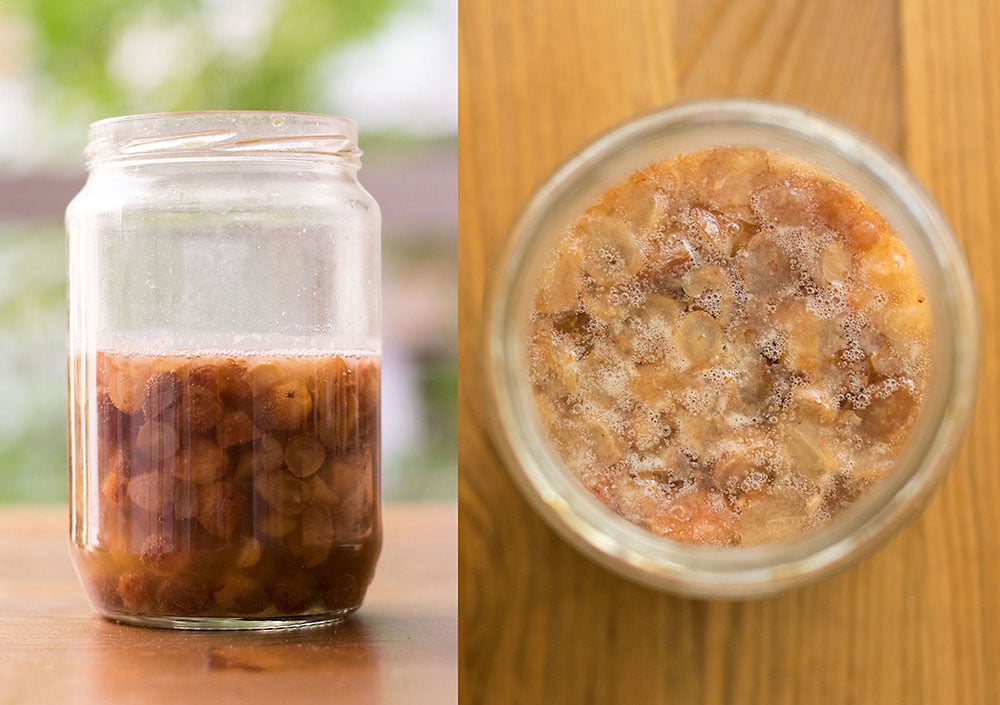
Day 8 (24 °C):
Bigger bubbles, stronger smell.

Strain raisin water and discard raisins.
Mix 1 cup (150 grams) flour, 1 teaspoon sugar and ⅔ cups (150 grams) raisin water. Keep covered in a warm place (under a lamp or in the oven with the light on). Let rise for 3-4 hours.

After the starter has increased in volume, add ⅔ cups spring water, 250 grams whole wheat flour, 100 grams bread flour, 2 teaspoons (10 grams) fine sea salt, 2 teaspoons oregano and 2 tablespoons olive oil. Keep covered in a warm place for 2-3 hours until doubled in volume, knead well and shape bread. Let it proof until almost doubled in size and bake in a preheated oven for 50 minutes.
As you can see from the previous pictures, I may have under-proofed my bread a little, meaning that it needed about an extra half hour to puff up a bit more and become fluffier. Nevertheless, it was delicious 🙂 Olive oil and oregano give it such a nice taste! Flavorwise, I can’t say it had a great difference from usual sourdough bread. It had the same crumb and taste with the same level of sourness. The starter itself though smells fruitier than your ordinary flour sourdough starter.
Some notes/tips:
- Use spring water. Tap water is usually chlorinated and that is something that kills live wild yeast and bacteria.
- Keep raisin water and dough in a warm place. A closed oven with only the oven light on or a place under a burning lamp is ideal.
- I’ve read that you can also use other kinds of fruit to make a fermented fruit-water, but have not tried it yet.
- Spray bread with water half-way through baking for a crunchier crust.
Similar recipes:
Mediterranean whole wheat pizza
White chocolate, saffron & goji berry olive oil babka
Share this post if you liked it (share buttons at the top!) and don’t forget to subscribe for new recipes or follow me on Instagram, Pinterest, Facebook
📖 Recipe
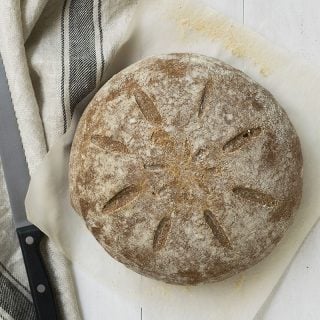
Raisin water starter sourdough bread
Ingredients
- For the starter :
- ⅔ cups (150 grams) fermented raisin water
- 1 cup (150 grams) all-purpose flour
- 1 teaspoon sugar
-
- For the rest of the ingredients :
- ⅔ cups (150 grams) spring water, warm
- 1 ⅔ cups (250 gram)s whole wheat flour
- ⅔ cups (100 grams) bread flour
- 2 teaspoons (10 grams) fine sea salt
- 2 teaspoons dried oregano
- 2 tablespoons olive oil
Instructions
- In a large bowl mix raisin water, all-purpose flour, and sugar and keep in a warm place until almost tripled in volume (about 2-4 hours). Add the rest of the ingredients and knead well by hand or using a mixer with the dough attachment. The dough should be elastic.
- Cover with a wet towel and leave in a warm place until doubled in volume (about 2-4 hours). Knead a little more and shape the bread (or you can just put it in a large loaf tin or two smaller ones). Let it rise until almost doubled in volume and score the surface with a sharp knife.
- Preheat your oven to 390°F (200°C).
- Bake the bread for 10 minutes, lower temperature to 356°F (180°C) and bake for 40 more minutes. Let on a rack to cool. Eat!
Notes
For a yeast starter, you’ll need: ⅔ cups (150 grams) warm water, 1 cup (150 grams) all-purpose flour, 1 teaspoon sugar, 1 packet (1 tablespoon) dry yeast
The rest of the ingredients and procedure remain the same.
Nutrition
If you like this post, Pin it!


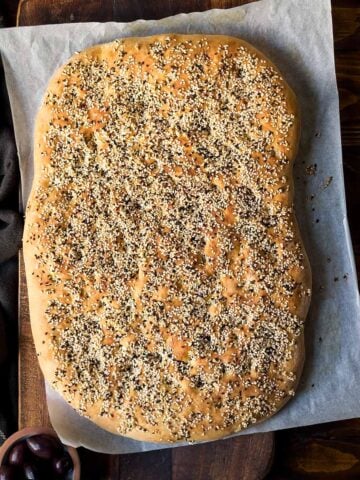
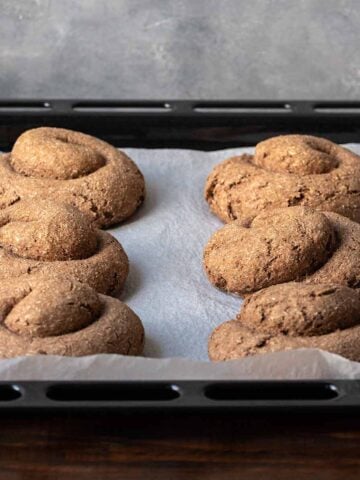
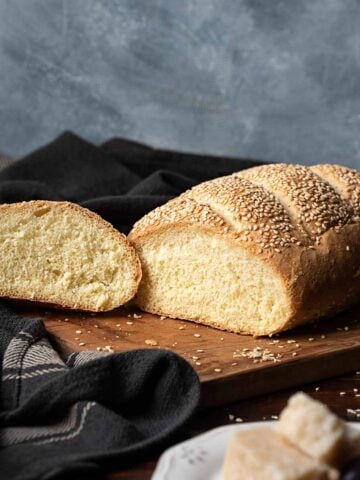

Caz McLaughlin says
I thoroughly enjoyed reading your post which came in on m Google+ stream. I will definitely be following you in the future on Pinterest and look forward to your posts.
This recipe reminds me very much of the rewena mother used to make as when I was young. There are many people of Maori descent across who still keep there traditions alive by making rewena. S especially like rewena peraoa, myself and there are many, many recipes on the web. if you feel inclined to look.
I admire the fact that you are keeping the traditions alive in sharing your memories and life experience in cooing. Have a safe and happy weekend. Looking forward to hearing from you again. Caz
Makos says
Hey Caz!
Thank you very much for your kind words!!!
I googled rewena and I'm so excited to have found another traditional bread recipe! You just made me very happy!!!!
See you! 🙂
JujaC says
Thank you for posting this recipe: I used to make my own bread, but was diagnosed as allergic to Baker/brewer yeast about a year ago. This has really limited my “bread” options, as even grocery store tortillas and pita bread have yeast added.
I can eat Sour dough breads, as it’s different yeast strain. This is the first one I’ve seen with Raisin Water and measurements in cups/tbsp, etc. I’m going to try this: I would love to be able to bake my own bread again!
Makos says
Thank you Juja!
Hope you like it!
Cait says
I made this with sourdough starter (since I already have some), and mixed in a little kamut flour with my whole wheat flour, and it was the BEST sourdough bread I have ever made. Thank you SO MUCH!
Makos says
Thank you Cait, I'll have to agree 🙂
It's amazing how a few simple ingredients like oregano and olive oil give such a great flavor to bread.
I've never used Kamut flour but I have read that you can substitute about one quarter of regular flour in recipes with delicious results.
Cait says
The kamut does give it a nice taste and also a very pretty light golden colour. 🙂
Odmaa says
Thank you for the amazing recipe. I’ve tried to create the raisin water starter, but mine had mold on top of in on the day 4 ? Could you help? I had put some raisin, with spring water in a jar, and left it uncovered in my kitchen.
Makos says
Hi Odmaa,
The only thing I can think of is that maybe the raisins weren't good. Did it smell alcoholic or the smell was bad?
Chris says
Do you have suggestions or a method of saving some of the starter (rather than restarting every time)? I’d love to have some starter that I continue to feed and use … maybe forever!
Makos says
Hi Chris, Natasha from myfailysourdoughbread has an article you will find useful ( http://www.mydailysourdoughbread.com/tag/dehydrated-sourdough-starter/ ). I have also dehydrated a dough with normal yeast and I am waiting for some time to pass to see if it works. I will write an article if everything goes well 🙂
Chris says
Thanks for the quick response. I was actually wondering about the raisin starter I just got going. Is there a way I could use some of it for a loaf of bread and then save some and keep the starter going to use the next day or the day after?
Makos says
If I want to use it after a few days I add all the starter to the recipe and then l keep a piece of dough in the fridge inside a glass jar or airtight container. This piece of dough can be fed and become a starter.
Chris says
Awesome. Thanks!
Jocelyn Wilson says
I was wondering if you could maintain the raisin starter like regular sourdough by keeping it fed. Or is this a one-time effort in lieu of sourdough starter? I made a batch and there was about 106 grams of raisin water left over, so I’ve added 106 grams of wheat flour to it. Since we’re all sheltering in place here in Sonoma County and yeast is next to impossible to find, this is an attractive option.
Makos says
Hi Jocelyn,
I haven't tried it but I don't see any reason why it will not work. If the microorganisms are kept alive they'll do their job ?
Joie says
Hi! If I don’t have whole wheat flour can I sub bread flour or AP flour? Thanks ?
Makos says
Hi Joie,
Yes you can. Reserve some tablespoons of flour and add them at the end if the dough is sticky. If it's still sticky, you may have to add a little more
Chris S says
This looks delicious! My mother in law has some sourdough starter, so I was going to use some of hers. You write: “For regular sourdough starter, you’ll need 300 grams starter 100% hydration”. What does that mean exactly? Does it mean I take 300g of the starter and add an equal amount of water?
Thanks.
Makos says
Hi Chris,
It means that the starter must be made with 150 grams flour and 150 grams water (the total weight is 300 grams and the water amount is 100% the flour)
Shriti Das says
I made this, the raisin water, starter and bread but it was too dense. What could have gone wrong? The dough was pretty hard, unlike those tacky ones that we see in videos. Apart from that, it was my first time with sourdough. But the raisin + flour starter mixture rose like a dream. I got it to rise 4X. Did I over–rise the starter?
Makos says
Hi Shriti,
I can't tell for sure, but I don't think it's a starter problem. Is it possible that you baked the bread before it had the chance to double in size? Or maybe the dough had more flour than needed?
Makos says
Also, my first bread was hard as a brick. But remember what they say: practice makes perfect!
Shriti Das says
Thanks for such a prompt response. And thanks for the recipe for the best starter I have come across.
So update on the bread:
1. I did not let it cool completely and cut through it because patience is clearly NOT my virtue. This morning, I toasted the bread and had with some butter and it tasted damn good. It is still dense and a little moist.
2. I made starter with the remainder raisin water and kept it in the fridge. I fed it again today and it raised like a dream. I feel that the dough did have more flour and I did not use bread flour. That could be another reason. But I now have starter at hand!
3. Also, I have been trying to make starter with water+flour but the mixture is way too stubborn. The raisin water starter is a dream and I got it right in the first go!
Makos says
From what I know so far, the best way to make starter with water+flour is to use whole wheat flour or whole rye flour (because the enzymes are found on the skin of the wheat). Also use non chlorinated water because chlorine can kill the starter.
Hope that helps!
Shriti Das says
Another update: Made an all-purpose flour sourdough bread with little whole-wheat (15%) and it's almost perfect despite mistakes like over-bulking. I am truly grateful that I now have a live kicking and strong starter in my fridge. Thanks again.
Shriti Das says
Forgot to rate the recipe!
Marianne says
Hi! I’m making my first raisin water yeast and on the morning of Day five I noticed a small, round, clearish growth of some sort. This was the day after small bubbles started forming. It looks a bit like what I see in the top of your photo, but yours may be raisin skins I’m seeing and mine is yeast or mold? I took it out and have pics, if interested? Or should I just toss it all and start anew. It is clear with maybe a little tinge if the same rusty water color of the raisins. It does not smell yet.
Makos says
Hi Marianne,
It could just be a little foam from the bubbles (?)
You can wait some more and see how it goes. If it starts to smell bad you should through it away.
You can send me the photos at thehungrybites.com@gmail.com
Betty says
I made the raisin water but on fifth day it was moldy. What went wrong?
Makos says
There could be a variety of reasons, so I can't tell for sure. Is it possible that the raisins had any preservatives or the water was clorinated? That would inhibite the growth of the yeast and give room for the mold to grow.
Samantha-Jane says
I have made this bread numerous times, in many variations, and it has always turned out perfectly.
As for the raisin water, I just keep feeding it sugar and spring water. I kept the first one going for over a year, with just the occasional addition of raisins and grapes. Eventually I had to discard it as it seemed to turn to pure alcohol after being forgotten about for a month or so.
My new one is bubbling away merrily and providing delicious delights!
Makos says
Hi Samantha-Jane!
Thats so great! Thank you so much for the feedback 💚
Sandra says
Can you share how to keep my Raisin starter going?
Makos says
Hi Sandra, you can feed it periodically like you would with sourdough starter. I don’t have a post for this on my site but you can find a lot of useful information online!
Ms T says
what do you with the leftover raisins?
Makos says
Hi, because they’re soaked for a long time, I discard them